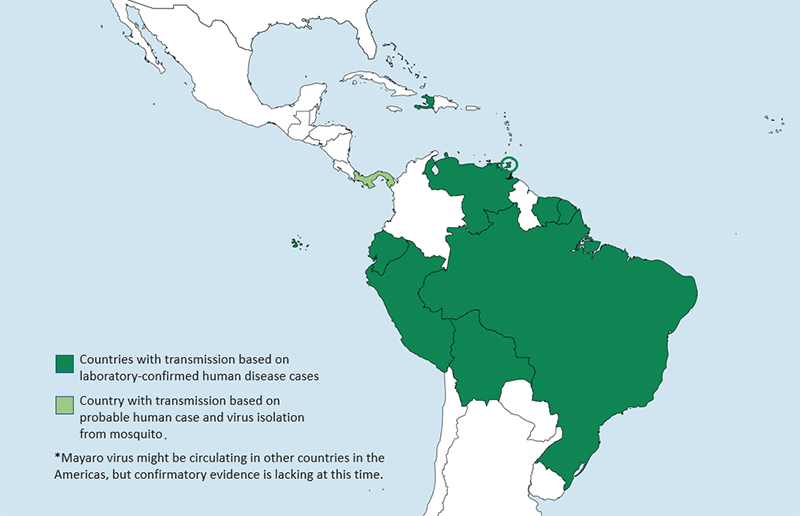For Healthcare Providers
Mayaro virus is an RNA virus in the genus Alphavirus (family Togaviridae). Mayaro virus was first identified in Mayaro county, Trinidad in 1954.
Epidemiology
Mayaro virus has been found in parts of South America, Central America, and the Caribbean. There have been no local (domestically-acquired) cases of Mayaro virus disease reported in the United States, but imported human cases from travelers who visited endemic areas have been reported. Brazil has reported the highest number of Mayaro virus disease cases. Other countries with confirmed cases include Bolivia, Ecuador, French Guiana, Haiti, Peru, Suriname, Trinidad and Tobago, and Venezuela. Mayaro virus transmission might be unrecognized or unreported in other countries. The primary vector of Mayaro virus is considered to be Haemagogus species mosquitoes. The enzootic transmission cycle involves these mosquitoes and non-human primates. The risk for infection is greatest in persons living near or visiting forested areas.

| Countries with transmission based on laboratory-confirmed human disease cases | Brazil, Bolivia, Ecuador, French Guiana, Haiti, Peru, Suriname, Trinidad & Tobago, Venezuela |
|---|---|
| Country with transmission based on probable human case and virus isolation from mosquito | Panama |
Clinical signs and symptoms
The incubation period for Mayaro virus infection is 1-14 days. Patients infected with Mayaro virus typically present with fever, headache, myalgia, arthralgia, chills, and rash. Arthralgia in the wrists, fingers, ankles, and/or toes is most commonly described, although elbows and knees are sometimes affected. The rash is typically maculopapular and usually appears 5 or more days after illness onset. Other symptoms can include eye pain, lymphadenopathy, abdominal pain, nausea, and vomiting. Leukopenia and occasionally mild thrombocytopenia can occur. Symptoms generally resolve in a few days to a few weeks, but some patients can develop long lasting arthralgias that can last up to a year after illness onset. Symptoms can be similar to other arboviral diseases that can occur in areas where Mayaro virus is endemic, including but not limited to dengue, chikungunya, and Zika virus disease. Co-infections with dengue or chikungunya viruses have been reported.
Treatment
There are currently no curative treatments for Mayaro virus infection. Often over-the-counter medicines can be used to reduce some symptoms. Patients should be advised to avoid aspirin containing drugs or other nonsteroidal anti-inflammatory drugs if dengue virus disease is suspected or has not been ruled out. Patients who develop more severe Mayaro virus disease may require hospitalization and supportive treatment.
Diagnosis
Testing for Mayaro virus infection is currently only available through CDC. Molecular and serologic tests can be performed in patients suspected of having Mayaro virus disease.
Please contact your local or state health department if you have a patient with compatible symptoms and a travel history to an area with possible Mayaro virus transmission. Information on submitting specimens to CDC for testing can be found here.